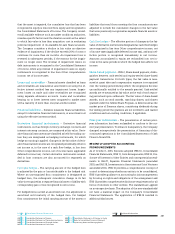Siemens 2014 Annual Report Download - page 260
Download and view the complete annual report
Please find page 260 of the 2014 Siemens annual report below. You can navigate through the pages in the report by either clicking on the pages listed below, or by using the keyword search tool below to find specific information within the annual report.
108 A. To our Shareholders 131 B. Corporate Governance 171 C. Combined Management Report
the difference between the return on plan assets and the
amounts included in net interest on the net defined benefits
liability (asset) and are recognized in Other comprehensive
income, net of income taxes.
Provisions – A provision is recognized in the Statement of
Financial Position when the Company has a present legal or
constructive obligation as a result of a past event, it is probable
that an outflow of economic benefits will be required to settle
the obligation and a reliable estimate can be made of the
amount of the obligation. If the effect is material, provisions are
recognized at present value by discounting the expected future
cash flows at a pretax rate that reflects current market assess-
ments of the time value of money. When a contract becomes
onerous, the present obligation under the contract is recog-
nized as a provision and measured at the lower of the expected
cost of fulfilling the contract and the expected cost of terminat-
ing the contract as far as they exceed the expected economic
benefits of the contract. Additions to provisions and reversals
are generally recognized in the Consolidated Statements of
Income. The present value of the recognized obligations associ-
ated with the retirement of property, plant and equipment
( asset retirement obligations) that result from the acquisition,
construction, development or normal use of an asset is added to
the carrying amount of the related asset. The additional carry-
ing amount is depreciated over the useful life of the related
asset. Additions to and reductions from the present value of
asset retirement obligations that result from changes in esti-
mates are generally recognized by adjusting the carrying
amount of the related asset and provision. If the asset retirement
obligation is settled for other than the carrying amount of the
liability, the Company recognizes a gain or loss on settlement.
Termination benefits – Termination benefits are provided as
a result of an entity’s offer made in order to encourage volun-
tary redundancy before the normal retirement date or from an
entity’s decision to terminate the employment. Termination
benefits in accordance with IAS , Employee Benefits, are rec-
ognized as a liability and an expense when the entity can no
longer withdraw the offer of those benefits.
Financial instruments – A financial instrument is any con-
tract that gives rise to a financial asset of one entity and a
finan cial liability or equity instrument of another entity. Finan-
cial assets of the Company mainly include cash and cash equiv-
alents, available-for-sale financial assets, trade receivables,
loans receivables, receivables from finance leases and derivative
financial instruments with a positive fair value. Cash and cash
equivalents are not included within the category available-for-
sale financial assets as these financial instruments are not sub-
ject to fluctuations in value. Siemens does not make use of the
category held to maturity. Financial liabilities of the Company
mainly comprise notes and bonds, loans from banks, trade pay-
ables, obligations under finance leases and derivative financial
instruments with a negative fair value. Siemens does not make
use of the option to designate financial assets or financial liabil-
ities at fair value through profit or loss at inception (Fair Value
Option). Based on their nature, financial instruments are classi-
fied as financial assets and financial liabilities measured at cost
or amortized cost and financial assets and financial liabilities
measured at fair value and as receivables from finance leases.
Financial instruments are recognized on the Consolidated State-
ments of Financial Position when Siemens becomes a party to
the contractual obligations of the instrument. Regular way
purchases or sales of financial assets, i.e. purchases or sales
under a contract whose terms require delivery of the asset
within the time frame established generally by regulation or
convention in the market place concerned, are accounted for at
the trade date.
Initially, financial instruments are recognized at their fair value.
Transaction costs directly attributable to the acquisition or
issue of financial instruments are only included in determining
the carrying amount, if the financial instruments are not
measured at fair value through profit or loss. Receivables from
finance leases are recognized at an amount equal to the net
investment in the lease. Subsequently, financial assets and
liabilities are measured according to the category – cash and
cash equivalents, available-for-sale financial assets, loans and
receivables, financial liabilities measured at amortized cost or
financial assets and liabilities classified as held for trading – to
which they are assigned.
Cash and cash equivalents – The Company considers all
highly liquid investments with less than three months matu-
rity from the date of acquisition to be cash equivalents. Cash
and cash equivalents are measured at cost.
Available-for-sale financial assets – Investments in equity
instruments, debt instruments and fund shares are all classi-
fied as available-for-sale financial assets and are measured at
fair value, if reliably measurable. Unrealized gains and losses,
net of applicable deferred income tax expenses, are recognized
in line item Other comprehensive income, net of income taxes.
Provided that fair value cannot be reliably determined, Siemens
measures available-for-sale financial instruments at cost. This
applies to equity instruments that do not have a quoted market
price in an active market, and decisive parameters cannot be
reliably estimated to be used in valuation models for the deter-
mination of fair value.
When available-for-sale financial assets incur a decline in fair
value below acquisition cost and there is objective evidence
























